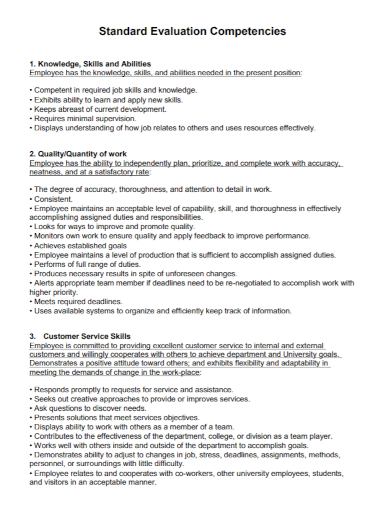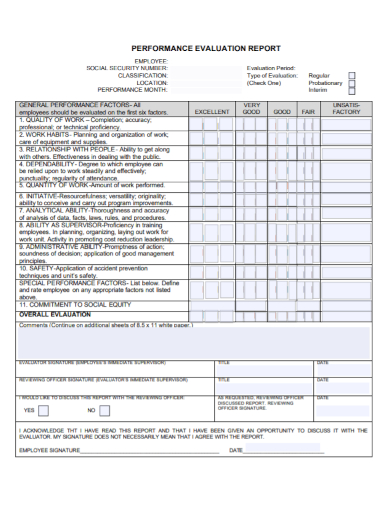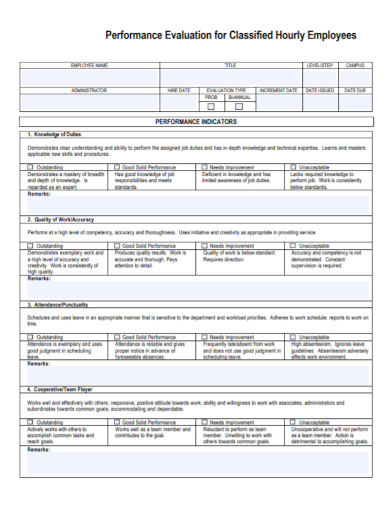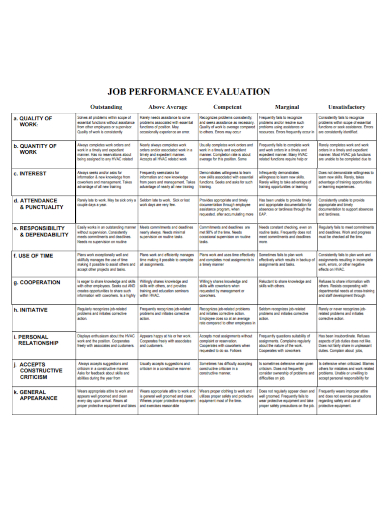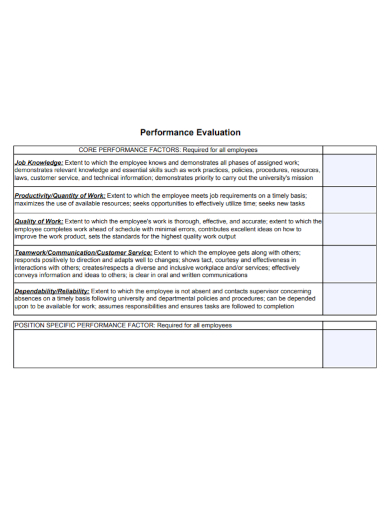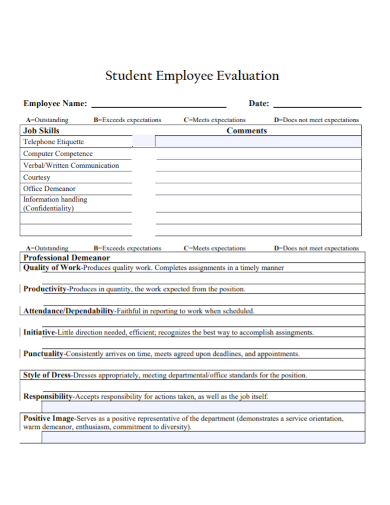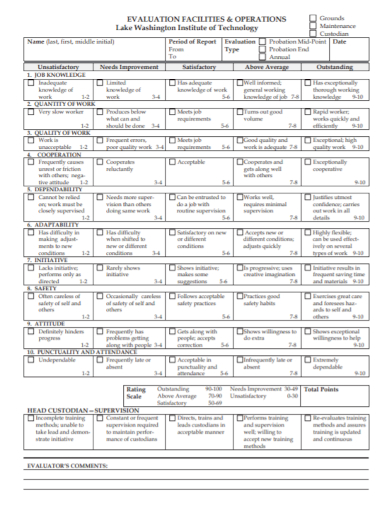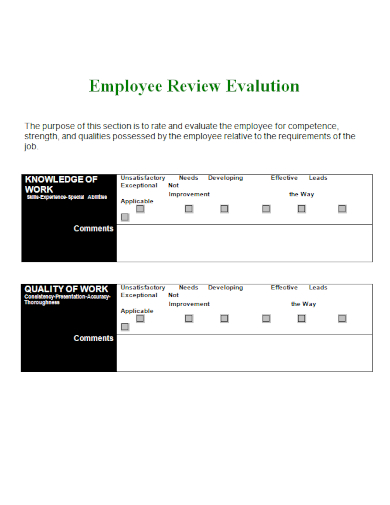To measure an employee’s work performance, management often conduct employee performance evaluation whether quarterly or annually. This is to ensure if staff are still working well and are meeting production targets. But merely working on a target and eventually finish your work isn’t all there is to it. Quality of work is one important key factor to evaluating work performance. Yet what is a complete task but filled with errors and inaccuracy? To be able to help appraise work quality for your employees, check out our quality of work evaluation samples below.
10+ Quality of Work Evaluation Samples
1. Quality of Work Evaluation
2. Quality of Work Performance Evaluation
3. Quality of Work Evaluation Report
4. Employee Quality of Work Evaluation
5. Quality of Work Job Performance Evaluation
6. Quality of Work Individual Performance Evaluation
7. Sample Quality of Work Evaluation
8. Community Quality of Work Evaluation
9. Quality of Work Student Employee Evaluation
10. Quality of Work Operations Evaluation
11. Quality of Work Review Evaluation
What Is Quality Of Work?
Work is a task to be undertaken, something we have to do or perform. We work to earn a living and for survival. In the business world, work is not merely trying to complete a task it requires quality, accuracy and efficiency. Quality and quantity must always work in balance for an employee to get a high performance rating. It is a domino effect as good quality work often results to customer satisfaction and higher productivity entails benefits and bonuses. Quality of work is one of the factors that makes up an employee evaluation.
How to Evaluate Quality of Work?
There are several points to consider while evaluating an employee’s quality of work depending on his job description, skill and knowledge. Carefully plan the evaluation and try to be objective as possible. There should be no favorites when it comes to employee evaluation, it should be conducted fairly and consistently to protect your employees and your practice. An efficient evaluation can lead to the improvement of an employee’s performance. So, in order to be able to effectively evaluate, here are some steps to consider:
1. Prepare an Evaluation Form
Evaluation forms or checklist are tools to guide the evaluator, who is usually a direct supervisor, team lead or manager. These would contain the employee’s essential work performance area, strengths and weaknesses, performance ratings and space for jotting down comments.
2. Establish Performance Measures
Performance measures are measurements that define outcomes or results. It is ultimately to drive future improvements in performance. These are essential for specific quality and quantity of goals that is attached to task that is listed in the job description. For example a bank teller‘s task is to assist clients with their banking needs such as deposits and withdrawals. The standard performance task for a teller is to assist 20 or more clients per day, but you need to check the quality of his or her work when it comes to encountering errors. Such example would be forgetting to check typos in a deposited check or counterfeit money. To begin developing standard performance measures, review the job descriptions for each position and select the key components of the job that can be specifically measured. This would greatly help understand what needs to be done or corrected.
3. Feedback
Now that you have established what areas need improvement, it is time to give feedback. Once again be objective and never based your comments solely on a personal feeling, so be professional about it. Feedback must always be based on both the strength and weaknesses of an employee and how he or she could use these to improve his or her working attitude and quality of his or her performance. When you address areas where improvement is needed, outline your expectations and how you intend to help the employee meet them. Feedback does not only come from the employer’s perspective but allow your employee to rate themselves in order to see if both parties can come up with a balanced and mutual solution.
4. Improvement Plan
After a thorough evaluation, it is time to set action plans to help support the employee reform his or her performance through performance improvement plan . These are objectives set and assigned by the manager to employees who require room for improvement in regards to their unsatisfactory performance review. Always try to consider based on data gathered, what are the major key areas that led to your employee’s decline in work quality. With that an improvement plan can be established.
5. Disciplinary and Termination Procedures
Unfortunately even though a chance to improve has been offered by the company, there still employees who refuse or are either too stubborn or contemptuous to change their ways leading to further decrease in quality of work. When this happens, management are compelled to take disciplinary actions on their employees to serve as a warning. Worst case scenario, they may have to fire them.
6. Evaluation Schedules
To continue to measure and guarantee your employees work quality and other important aspects of his task, it is imperative to conduct evaluation not just once a year but in a quarterly basis. In this way, management has better hold on their employees performance. Not because they want to continue to judge them, but to help them improve.
FAQs
What Is a Performance Goal?
A performance goal are work targets set up by a manager for their employees. These are objectives that an employee is expected to achieve within a set period of time.
What Is Job Analysis?
The purpose of Job Analysis is to provide information to determine if a particular job is a right fit for an employee and that collecting information on characteristics that differentiate jobs.
What is KPI?
KPI or Key Performance Indicators are quantifiable measure of performance over time for a specific objective.
Maintaining the integrity, health and productivity of employees is one of the major task business organization are obliged to do. Employees whether new or old are always bound to encounter problems with their performance, as mistakes is a part of being human. Thus corrective or preventive measures are imposed with the mutual understanding from the management and employee. This is not to look down on employees but a way to help get a better understanding of their mistakes and what can be done to improve it. After which this will create growth and development and increasing productivity which can be beneficial for all.
Related Posts
FREE 10+ Scholarship Evaluation Samples [ Interview, Training, Monitoring ]
FREE 10+ Dependability Evaluation Samples in PDF | DOC
FREE 10+ Quantity of Work Evaluation Samples [ Employee, Self, Performance ]
FREE 10+ Heuristic Usability Evaluation Samples [ Website, Testing, Inspection ]
FREE 10+ Job Knowledge Evaluation Samples [ Employee, Skills, Self ]
FREE 10+ Consultant Performance Evaluation Samples in PDF | DOC
FREE 10+ Job Interview Evaluation Samples [ Teacher, Candidate, Performance ]
FREE 10+ Grant Proposal Evaluation Samples in PDF | DOC
FREE 10+ Faculty Performance Evaluation Samples in PDF | DOC
FREE 10+ Internship Evaluation Samples [ Supervisor, Self, Performance ]
FREE 10+ Resident Evaluation Samples [ Medical, Self, Rotation ]
FREE 10+ Dissertation Evaluation Samples [ Critical, Service, Self ]
FREE 3+ Front Desk Evaluation Samples [ Performance, Receptionist, Employee ]
FREE 10+ Vendor Performance Evaluation Samples in PDF | DOC
FREE 10+ Thesis Evaluation Samples [ Master, Defense, Project ]

